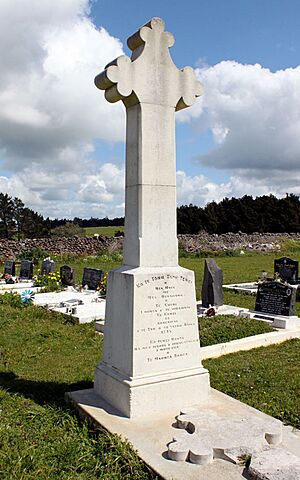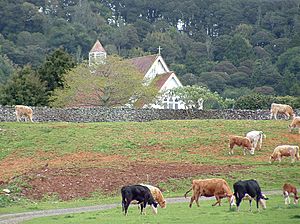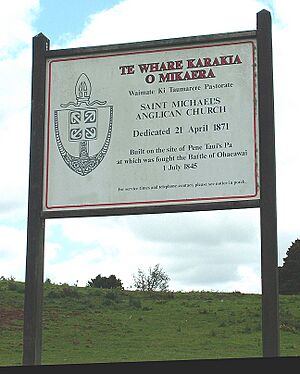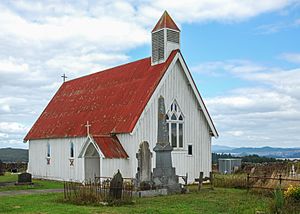Battle of Ohaeawai facts for kids
Quick facts for kids Battle of Ohaeawai |
|||||||
|---|---|---|---|---|---|---|---|
| Part of Flagstaff War | |||||||
|
|||||||
| Belligerents | |||||||
| Māori | |||||||
| Commanders and leaders | |||||||
| Lieutenant Colonel Henry Despard: 58th Regiment ~ 10 officers and 200 men; 96th Regiment - 'a company'; 99th Regiment ~ 7 officers and 150 men; Tāmati Wāka Nene ~ 400 warriors HMS Hazard ~ 10 officers and men Auckland Volunteer Militia ~ 30 men |
Te Ruki Kawiti ~ 150 warriors Pene Taui ~ 150 warriors |
||||||
| Casualties and losses | |||||||
| 33 dead, 66 wounded | light | ||||||
The Battle of Ohaeawai was a fight between British soldiers and local Māori warriors. It happened in July 1845 at Ohaeawai in the North Island of New Zealand. This battle was part of a larger conflict called the Flagstaff War.
A powerful Māori chief named Te Ruki Kawiti led the Māori forces. This battle was very important. It showed that a strong, fortified Māori village, called a pā, could survive attacks from cannons. It also proved that charging directly at a pā would cause many losses for the attacking soldiers.
Contents
Building the Ohaeawai Pā
After another battle, called the Battle of Te Ahuahu, chiefs Te Ruki Kawiti and Pene Taui discussed where to fight next. Kawiti agreed to help fortify Pene Taui's pā at Ohaeawai.
In the winter of 1845, Lieutenant Colonel Despard led British troops. These soldiers were from the 58th, 96th, and 99th Regiments. They were joined by Royal Marines and Māori allies. Their goal was to attack the Ohaeawai Pā, which Kawiti had made very strong.
British Attack on the Pā
The British soldiers arrived at Ohaeawai Pā on June 23. They set up their camp about 500 metres (1,640 feet) away. On a nearby hill called Puketapu, they built a battery with four cannons.
They started firing their cannons the next day and continued until dark. However, the cannon fire did very little damage to the pā's strong walls. The next day, the cannons were moved closer, to about 200 metres (656 feet) from the pā.
The bombardment went on for two more days, but still caused little harm. This was partly because the pā's palisades (fences) were covered with layers of flax leaves. The flax made the walls flexible and helped stop musket balls. The main problem was that the cannons did not focus their fire on one spot. This meant they couldn't create a large hole in the palisade.

In English, it translates as, “This is a sacred memorial to the soldiers and sailors of the Queen who fell in battle here at Ohaeawai in the year of Our Lord 1845. This burying place was laid out by the Maoris after the making of peace.”
After two days of shooting without breaking through, Colonel Despard wanted to charge the pā directly. He was convinced to wait for a larger 32-pound naval cannon, which arrived on July 1.
However, the Māori defenders suddenly rushed out of the pā. They briefly took over the hill where Tāmati Wāka Nene and his Māori allies were camped. They even captured Nene's flag, which was a Union Jack.
The Reckless Assault
The captured Union Jack was taken into the pā. It was then raised upside down and at half-mast, below a Māori flag. This was a great insult to the British.
Colonel Despard was very angry about the insult to the Union Jack. He immediately ordered an attack on the pā that same day. The attack was aimed at a part of the pā where the defenders could easily shoot at the attackers from two sides. It was a very risky plan.
The British soldiers kept trying to storm the unbroken palisades. In just five to seven minutes, 33 soldiers were dead and 66 were injured. Among the dead were Captain Grant and Lieutenant Phillpotts. A Māori spiritual leader made predictions of victory against the British.
Despard was shocked by losing so many soldiers. He decided to give up the siege. But his Māori allies disagreed. Tāmati Wāka Nene persuaded Despard to wait a few more days. More supplies and ammunition arrived, and the shelling continued.
On the morning of July 8, the pā was found empty. The Māori defenders had left during the night. When British officers inspected the pā, they found it was even stronger than they had thought.
Pā Design and Defense
The pā defenders had four iron cannons on ship-carriages. One of these was a carronade, which they loaded with a bullock-chain to fire at close range. The British captured these cannons, though one had been destroyed by a British shot.
A drawing by Mr. Symonds of the 99th Regiment showed the inner palisade of Ohaeawai. It was 3 metres (10 feet) high and made of strong Puriri logs. In front of this inner wall was a ditch. Warriors could hide in this ditch, reload their muskets, and then fire through gaps in the two outer palisades.
Marianne Williams, whose husband Henry observed the battle, was amazed by the clever design of the pā. She noted that the Māori seemed to defy the British with their forts. They had double fences, ditches, and loopholes. Their houses were dug underground. The fences were covered with loose flax bunches. This made bullets fall off without doing much harm. Any holes made by cannons were quickly fixed at night.
The pā was eventually destroyed, and the British went back to the Bay of Islands. Te Ruki Kawiti and his warriors escaped. They then built an even stronger pā at Ruapekapeka. The Battle of Ohaeawai was presented as a British victory, even though they lost many soldiers. In reality, Kawiti and his warriors had simply left the pā as a smart move. They moved on to build the Ruapekapeka Pā to fight the British on a battlefield chosen by Kawiti.
Hone Heke did not fight in the Battle of Ohaeawai. He was still recovering from injuries he got at the Battle of Te Ahuahu.
How Ohaeawai Pā Changed Fortifications
After the battle, models of the pā's design were made. One was sent to Britain. Other Māori tribes learned from the Ohaeawai Pā's design. They learned how to make forts that could reduce the power of cannons and muskets. They also learned to build firing trenches inside the pā and connecting trenches to underground shelters.
The design of Ohaeawai Pā, and the pā Kawiti later built at Ruapekapeka, became the basis for what is now called the gunfighter pā.
Where the Battle Took Place
The place where the battle happened is now called Ngawha. But at the time of the battle, it was known as Ohaeawai.
According to Cowan, the Ohaeawai pā site is now home to a Māori church and a burial ground. The battle site is about five miles from Kaikohe and two miles from the modern town of Ohaeawai. An old-fashioned Māori church can be seen on the left when traveling from Kaikohe. It stands on a small hill west of the main road. This area is usually called Ngawha because of the hot springs nearby. However, this is the true Ohaeawai battle site. The European town that took the name Ohaeawai should actually be called Taiamai.
The church stands in the middle of the old fort. A stone wall, 7 feet (2.1 metres) high, surrounds the sacred ground. The church itself was built on the pā site in 1870.




